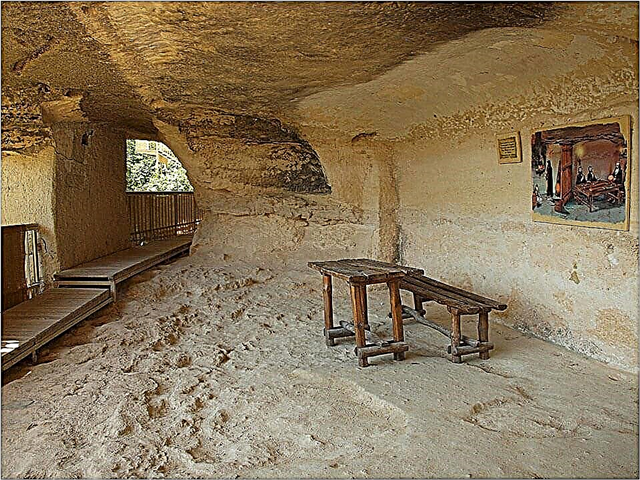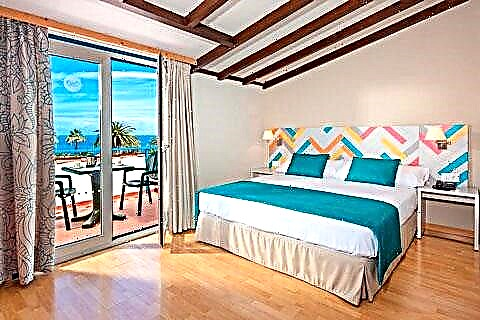The city-reserve 26 km from Vladimir is small in size. Suzdal covers an area of 15 square kilometers and is home to less than 10 thousand people. Surprisingly, there are over 50 churches in a small provincial town. We will tell you about the most interesting temples, belfries and cathedrals of Suzdal, which are considered the pearls of Russian architecture and the real keepers of the history of Russia.

Cathedral of the Nativity of the Virgin in the Suzdal Kremlin
Suzdal record holders
If you look closely at the map of the city, it becomes clear that in the old days the builders had a special aesthetic taste. Almost all the architectural monuments of Suzdal stand in prominent places. Temples were built on the hills and banks of the Kamenka. They are reflected in the waters of a small river and look very picturesque. Some churches are located in the territories of the ancients monasteries of Suzdal, others decorate the commercial part of the city - Posad, and still others are erected on the outskirts, in the settlements.
The oldest temple is located on the territory Suzdal Kremlin... The majestic Cathedral of the Nativity of the Virgin was built in the 1220s on the site of an older church of the 12th century. Initially, the temple had three chapters, but in the 15th century the cathedral became five-domed. Today it is a functioning church and museum. Inside you can see the famous Golden Gate and magnificent paintings.

Venerable bell tower of the Robe Deposition Monastery
What is the tallest church in Suzdal? The small town has low-rise buildings, therefore the Venerable bell tower Monastery of the Robe seen from afar. The three-tiered tower rises to a height of 72 m and is the tallest church building in the city. An excellent panorama of the streets, domes of Suzdal temples, the picturesque valley of the Kamenka River and the green outskirts of Suzdal opens up from the old bell tower.
Churches on the territory of Posad
In the center of the city there is the second most important part of Suzdal after the Kremlin - the trade and craft Posad. The "third estate" lived in the township streets - merchants, craftsmen and artisans. The unique church ensemble of Posad was formed 3-4 centuries ago, thanks to the wealthy Suzdal merchants.

View of the Church of the Resurrection at the auction (left) and the Kazan temple (right)
In the heart of Posad is the Trade Square. Previously, goods were brought here from Vladimir, Rostov and Nizhny Novgorod. The ancient market is decorated with two architectural monuments - a snow-white one-headed Church of the Resurrection at Torgu and strict Kazan temple.
These churches look very harmoniously next to each other and represent an example of the so-called "twin" temples. Previously, there were wooden churches at the trading place, but in 1719 there was a strong fire in Suzdal.

View of the Kresto-Nikolskaya Church
The raging flames destroyed the city center, and all the wooden buildings burned to the ground. After the fire, two stone churches appeared in the wasteland - "summer" and "winter", so the townspeople could come to church services at any time of the year.
Near the northern part of the shopping arcade in 1770 was built Kresto-Nikolskaya church... Its architecture is notable for the fact that the temple looks different from different sides.

View of the Church of the Beheading of John the Baptist
From the southern part of the old market, near the fortifications of the Kremlin, there is a small one-headed Church of the Beheading of John the Baptist.
Temple ensembles in the historic center

View of the Pyatnitskaya Church (left) and the Entry-Jerusalem Church (right)
On the western side of the Trading Rows, on the high bank of the Kamenka, you can see other "paired" temples - Entry Jerusalem Church and Pyatnitskaya church... In the old days, there were three wooden buildings between the Market Square and the fortifications of the Kremlin. At the beginning of the 18th century, the dilapidated churches were dismantled and replaced with stone ones.
The first temple was erected in 1707, and the second in 1772. It is noteworthy that the later church was first consecrated in honor of Nicholas the Wonderworker. However, the people of Suzdal loved their wooden temple of Paraskeva Pyatnitsa so much that they continued to call the new temple Pyatnitsky.

View of the Antipievskaya Church (left) and Lazarevskaya Church (right)
Another "pair" ensemble is located on Staraya Street, between the Monastery of the Robe and the Trading Rows. Lazarevsky temple was built in 1667 and today is the oldest church in Posada.
This is an unusual example of Suzdal architecture. For the first time, builders erected a five-domed temple in the city, and glazed tiles were used in the decor of its cornices. Openwork light drums, curly platbands and neat kokoshniks of this temple are so good that it is difficult to look away from it!

View of the Tsarekonstantinovsky temple
You can see a warm Antipiev Church... It was built later - in 1745 and dedicated to Bishop and Hieromartyr Antipas, who lived in the 1st century AD, when Rome Emperor Nero ruled. Like all winter churches in the city, Antipievskaya Church has a simple design and small size. Thanks to the elegant multi-colored bell tower, the architectural ensemble of the two Suzdal temples is the most recognizable in the city.
A few steps from each other stand Tsarekonstantinovsky temple and Sorrowful Church Suzdal. They are located next to the square where the Eternal Flame is burning. In the old days, there was a horse-drawn Nizhny Novgorod tract that connected Suzdal and the Volga region. The wooden church in honor of Tsar Constantine was built at the beginning of the 17th century. Almost 100 years later, it was replaced by a stone one.

View of the Sorrowful Church
At the end of the 18th century, a winter church dedicated to the Joy of All Who Sorrow icon appeared nearby. The magnificent white temple consists of multi-high cages, a refectory and a bell tower typical of Suzdal. It is decorated with elegant brick patterns and colored tiles.
Churches that stand in Suzdal settlements
A wonderful "pair" ensemble is located near the ancient Spaso-Euthymius Monastery, on the main street of the city. Summer Smolensk Church and winter temple of St. Simeon appeared in the settlement almost simultaneously, at the turn of the 17th-18th centuries.

View of the Church of St. Simeon (left) and Smolensk Church (right)
Several centuries ago, peasants lived on these lands, who were brought from the monastic estates. In Suzdal, they performed the work necessary for the city, retrained and became artisans, bricklayers and brick-makers.
Former farmers missed their homes, so the local settlement was called "Skuchilovo" or "Skuchilikha". According to another version, the unusual name arose because in the settlement "congregated" carts that carried goods from Moscow, Shuya, Kostroma and Yaroslavl.

View of the temple of Elijah the Prophet
On the opposite bank of the Kamenka, on Ivanova Hill, an old temple of Elijah the Prophet... The church stands on a high two-height cube, which is quite rare in the architecture of Suzdal. The openwork bell tower of the Elias Church was restored in 2010.
In the former Kozhevennaya Sloboda, on the outskirts of Ilyinsky meadow, there is a "pair" ensemble Church of the Nativity of John the Baptist and Epiphany Church... They are located near the low right bank of the Kamenka River.

View of the Nativity Church (left) and Epiphany Church (right)
The Nativity Church was built in 1739 and the second temple was built in 1781. The money for the construction of both churches was raised by the parishioners themselves. Lovers of Russian architecture come here to admire the mixture of architectural styles typical of Russia in the 17th and 18th centuries.
On the outskirts of the city, in the place where the Andreevsky Monastery used to be located, you can see another temple of the former Kozhevennaya Sloboda - Tikhvin Church... The Orthodox monastery was burned down during the invasion of the Poles, and the stone church was built at the end of the 17th century.A difficult fate awaited the church, and to this day the old building has been preserved with great losses.

View of the Tikhvin Church
The memory of another destroyed Christian monastery of Suzdal is kept Church of the Deposition of the Robe and Znamensky temple... They stand on the steep bank of a small tributary of the Kamenka - the Mzhara River. For a very long time, the village of Pinaikha and the Vvedensky nunnery were located here. The Orthodox monastery was razed to the ground during the invasion of the Tatar-Mongols at the beginning of the 13th century, and the village at the end of the 17th century became part of the city. According to its name, the area began to be called "Pinaev side".

View of the Znamensky Temple (left) and the Church of the Deposition of the Robe (right)
Near Museum of Wooden Architecture, on the Borisoglebskaya side, there is a red brick the temple of Boris and Gleb... This is all that remains in Suzdal from the old Borisoglebsk monastery.
One-headed Kosmodemyanskaya church and a slender tent-roofed bell tower stand on a hill, which from ancient times has been called "Yarunovaya Gora". The beautiful temple can be clearly seen from the large bridge over the Kamenka River.

View of the Church of Boris and Gleb on the Borisov side
In the former Nikolskaya Sloboda, a "pair" ensemble of Peter and Paul Church and Nikolsky Church... Previously, there was a female Pokrovsky monastery here. It was to this monastery in 1698 that Peter I exiled his wife, the disagreeable Tsarina Evdokia Lopukhina.

View of the Kozmodemyanskaya Church on Yarunova Gora
Over the course of several centuries, a variety of temples were built in Suzdal - one-domed and five-domed, pillarless and two-pillar, cubic, "cage" and tiered. The builders used various architectural techniques and decorative finishes. They attached high bell towers to almost all the churches with an unusual tent-pipe, characteristic only of the Suzdal region.

View of the Peter and Paul Church (right) and Nikolskaya Church (left)
We must pay tribute to the Suzdal architects, they were real masters! Despite the apparent discrepancy in forms, silhouettes and styles, all the temples of the ancient city are distinguished by amazing beauty and natural sense of proportion.











